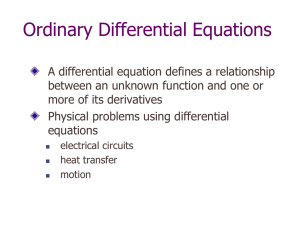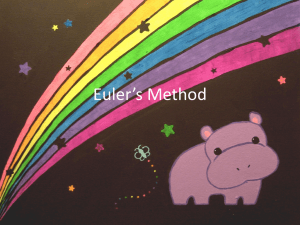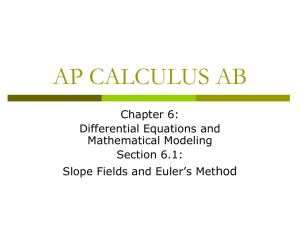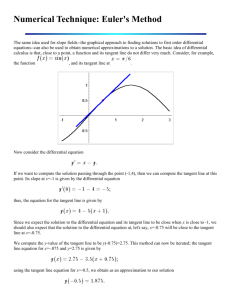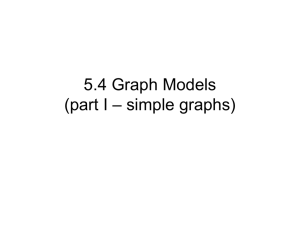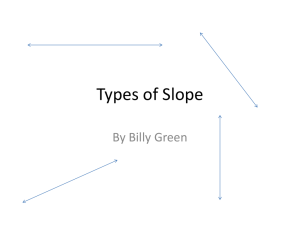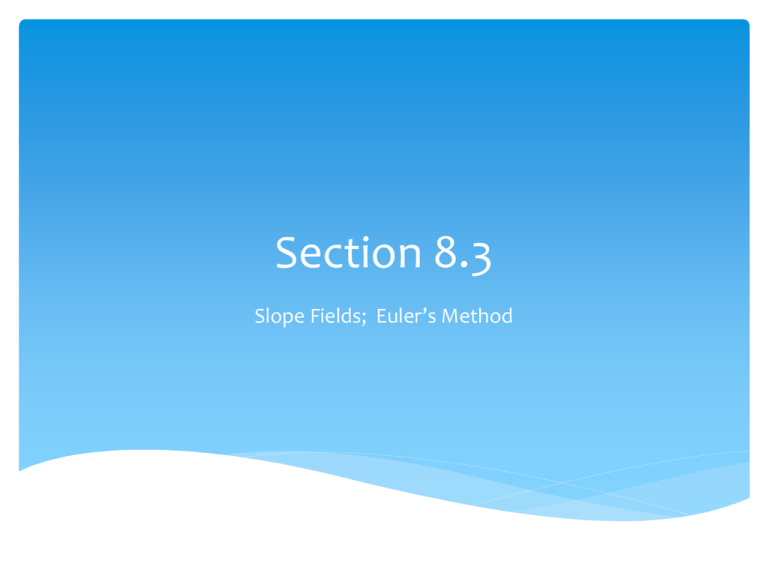
Section 8.3
Slope Fields; Euler’s Method
All graphics are attributed to:
Calculus,10/E by Howard Anton, Irl Bivens, and
Stephen Davis
Copyright © 2009 by John Wiley & Sons, Inc. All
rights reserved.
Introduction
In this section we will deal with more slope fields,
including those with two variables.
We will also examine a method for approximating
solutions of first-order equations numerically that can
be used when differential equations cannot be solved
exactly.
Functions of Two Variables
NOTE: For this section, we will use first-order
differential equations with the derivative by itself on
one side of the equation to make things easier.
In Section 5.2, we dealt with slope field problems that
contained one variable and were in the form y’ = f(x).
We will continue some work with those, and will
begin slope field problems that contain two variables:
y’ = f(x,y)
or
y’ = f(t,y) if time is one of the variables.
Slope Fields Involving Two Variables
The same principals we used with slope fields
involving one variable in section 5.2 apply to slope
fields involving two variables.
A geometric description of the set of integral curves
can be obtained by:
1. choosing rectangular points (x,y)
2. calculating the slopes of the tangent lines to the
integral curves at the grid-points
3. drawing small segments of those tangent lines
through the chosen points
The resulting picture is a slope field.
Example: Slope Field Involving Two
Variables
Sketch the slope field for
y’ = y-x at the 49 grid-points (x,y)
where x = -3, -2, …, 3 and y = -3, -2,
…, 3 .
1.
2.
3.
choosing rectangular points
(x,y): given
calculating the slopes of the
tangent lines to the integral
curves at the grid-points:
above right
drawing small segments of
those tangent lines through
the chosen points: right
Example Continued with Integral
Curves
If you have trouble
envisioning the integral
curves, you may want to
draw tangent line
segments at more gridpoints, but it is a lot of
work (original on left,
more grid-points on
right).
This should help you see
the general shape of the
integral curves (below).
General Solution
The general solution for the differential equation on
the previous slides y’ = y – x is:
y = x + 1 + Cex
If we were to continue in Chapter 8 (Section 8.4) we
would find out how to solve for that exactly.
However, as we discussed, differential equations
comprise entire courses in college. Therefore, we
must stop somewhere.
Euler’s Method
This graph helps us develop a method for approximating
the solution to the initial-value problem y(𝑥0 ) = 𝑦0
numerically.
We will choose some small increment ∆𝑥 as we did in some
sections last year and approximate y(x) at multiple values,
starting at 𝑥0 which will look like:
𝑥1 = 𝑥0 +∆𝑥
𝑥2 = 𝑥1 +∆𝑥
𝑥3 = 𝑥2 +∆𝑥
𝑥4 = 𝑥3 +∆𝑥
Et cetera
NOTE: Other, better methods, often use Euler’s Method as
a starting point.
Euler’s Method
con’t Using a
Simpler Graph
In order to find the slope of each segment, use the given equation
and the 𝑥𝑠 you found using the information on the previous slide and
𝑦 −𝑦
𝑦
−𝑦
your algebra one slope formula 2 1 which becomes 𝑛+1 𝑛 when
𝑥2 − 𝑥1
𝑥𝑛+1 − 𝑥𝑛
you are making repeated calculations.
𝑦𝑛+1 −𝑦𝑛
𝑥𝑛+1 − 𝑥𝑛
𝑦𝑛+1 −𝑦𝑛
=
∆𝑥
𝑦𝑛+1 − 𝑦𝑛 = f(𝑥𝑛 , 𝑦𝑛 )* ∆𝑥
multiply both sides by ∆𝑥
𝑦𝑛+1 = 𝑦𝑛 + f(𝑥𝑛 , 𝑦𝑛 )* ∆𝑥
add 𝑦𝑛 to both sides
This is the heart of Euler’s Method: 𝑦𝑛+1 = 𝑦𝑛 + f(𝑥𝑛 , 𝑦𝑛 )* ∆𝑥
NOTE: it is basically point-slope form of a line with modifications
= f(𝑥𝑛 , 𝑦𝑛 )
Formal Description of Euler’s Method
Example:
Use Euler’s Method with a step size of 0.1 to
make a table to approximate values of the solution of the
initial-value problem y’ = y-x , y(0) = 2 over the interval [0,1].
Why we need Euler’s Method
If you look at the derivative in the previous example
which was y’ = y-x, you will find that you cannot
separate the variables like we did in section 8.2.
𝑑𝑦
𝑑𝑥
=𝑦 −𝑥
𝑑𝑦 = 𝑦 − 𝑥 𝑑𝑥
multiply by dx
𝑑𝑦 = 𝑦𝑑𝑥 − xdx
distribute
𝑑𝑦 − 𝑦𝑑𝑥 = xdx
subtract ydx
That is why we made the table in the previous example.
Accuracy of Euler’s Method
When determining how far the Euler approximation is
compared to the exact solution, it is helpful to
remember that the error is proportional to the step
size.
Therefore, the smaller the step size used, the greater
the accuracy in the Euler approximation.
Also, the absolute error tends to increase as x moves
away from x0.
Absolute Error and Percentage Error
Absolute Error = 𝑒𝑥𝑎𝑐𝑡 𝑣𝑎𝑙𝑢𝑒 − 𝑎𝑝𝑝𝑟𝑜𝑥𝑖𝑚𝑎𝑡𝑖𝑜𝑛
Percentage Error =
𝑒𝑥𝑎𝑐𝑡 𝑣𝑎𝑙𝑢𝑒 −𝑎𝑝𝑝𝑟𝑜𝑥𝑖𝑚𝑎𝑡𝑖𝑜𝑛
𝑒𝑥𝑎𝑐𝑡 𝑣𝑎𝑙𝑢𝑒
* 100%
Euler Approximation Error Example
The exact solution to the initial-value problem in Example 1
is y = x + 1 + ex.
If you are not sure why, look back at the “General
Solution” slide and substitute the initial condition y(0)=2.
Resulting table of
solutions and errors:
The End
The following slides are for use in class to go over
some of the exercises.
Exercise #3
Exercise #3 All in One Graph
Exercise #6
Exercise #6 Matching
Exercise #17
Solution to #17b



